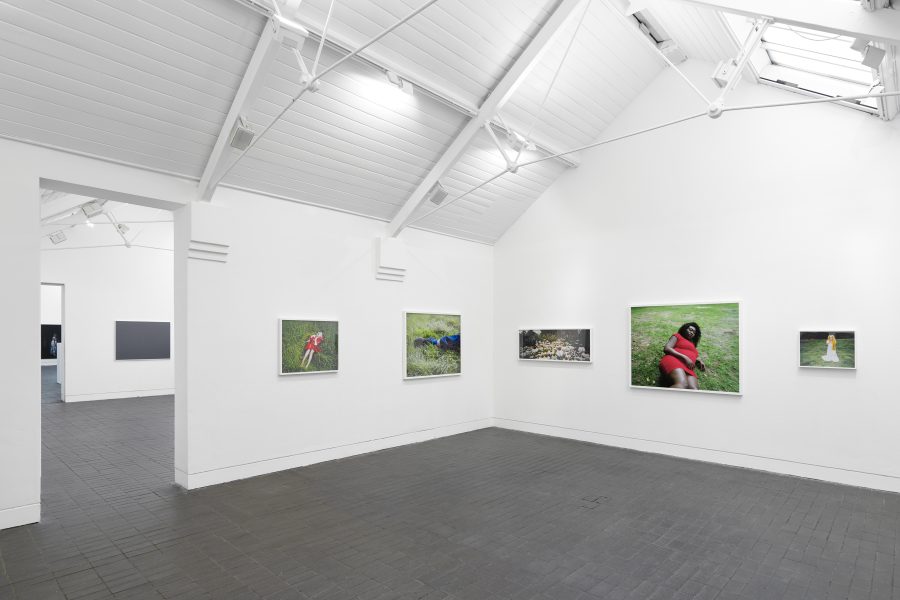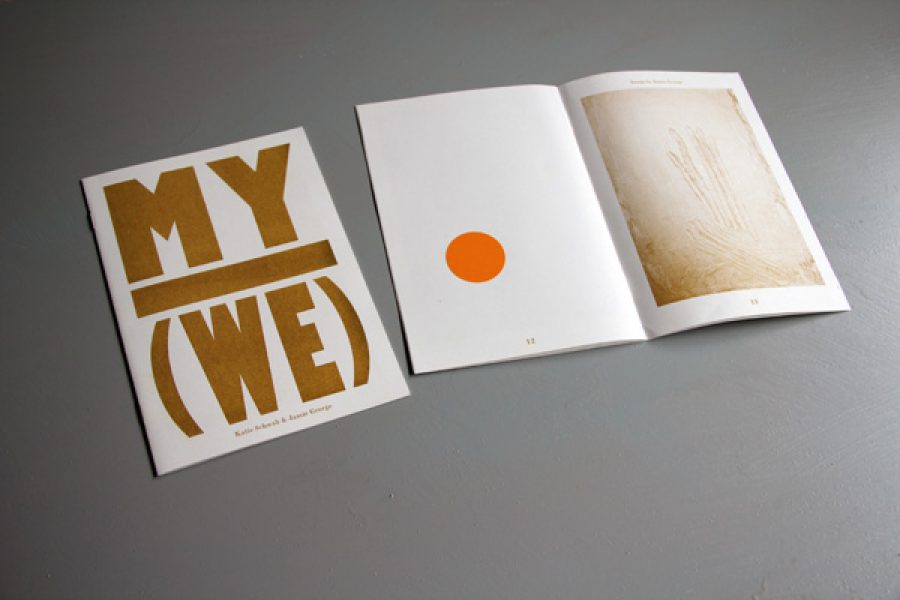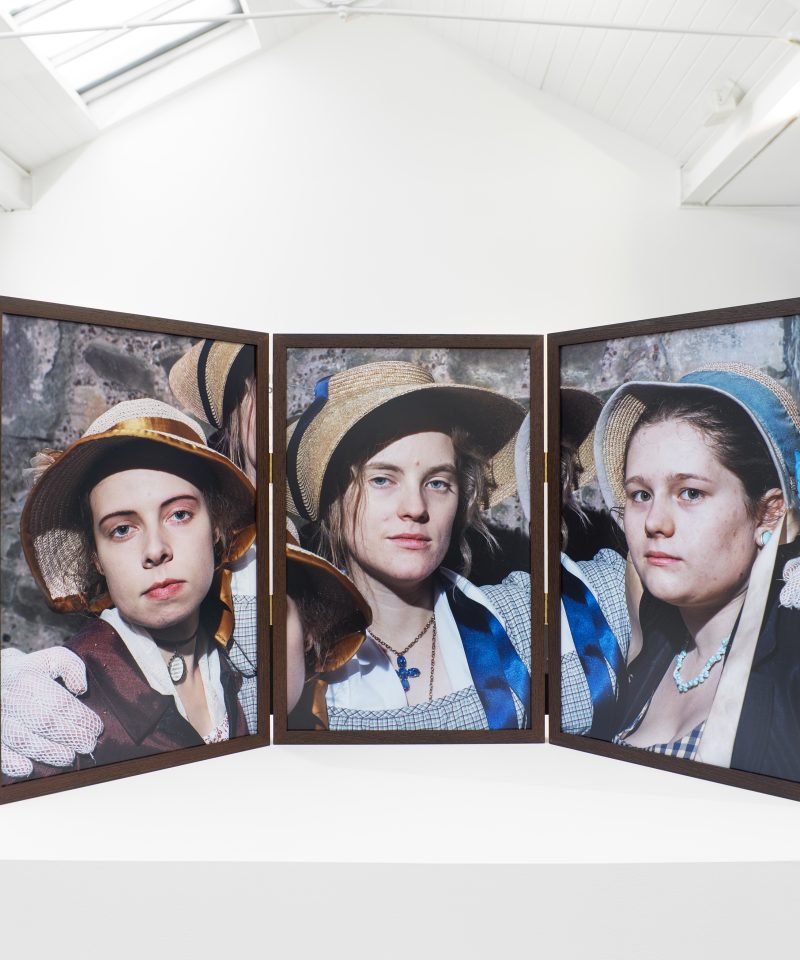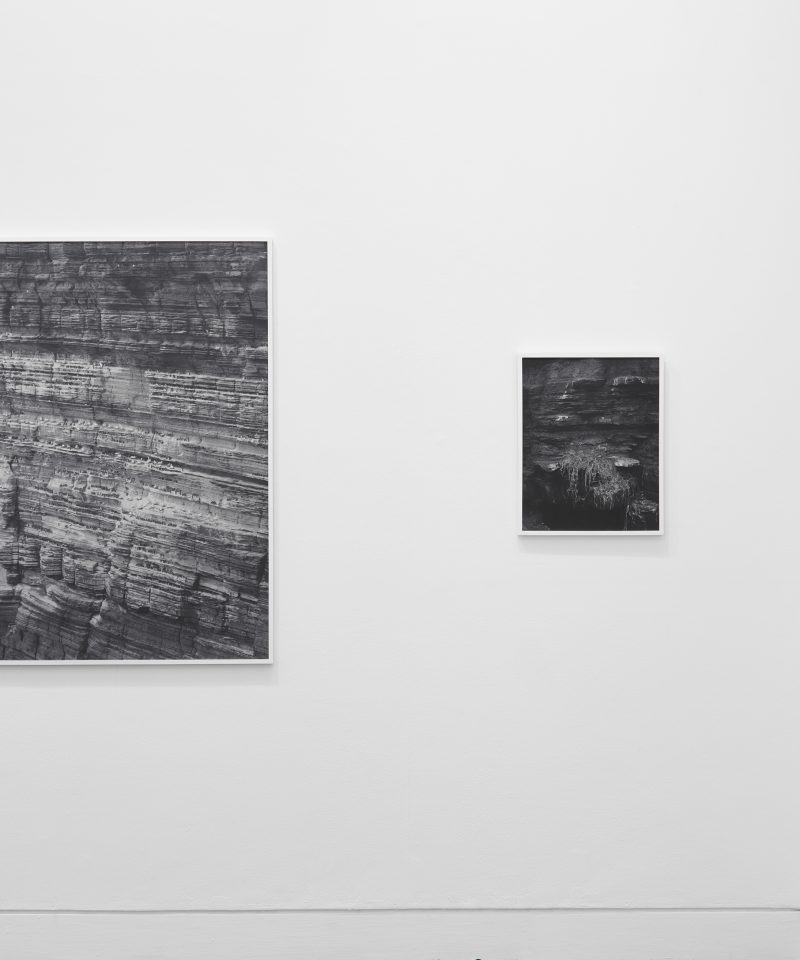Re-enactment and role-play are recognisable strategies in contemporary art. Sharon Hayes’s In My Little Corner of the World, Anyone Would Love You (2016), for instance, in part comprises a video installation in which members of Philadelphia’s contemporary queer and feminist communities recite extracts from print newsletters and small-run publications self-published between 1955-1977 by US and UK based feminist and lesbian political collectives, re-embodying these earlier writings. In a series of 2005 actions as part of her In the Near Future project, Hayes re-staged protests of the past, holding placards with the slogans of previous political moments. Perhaps best known, Jeremy Deller’s The Battle of Orgreave (2001), recreated a pitched battle between miners and policemen in Yorkshire that happened during the 1984 miners’ strike.
Alejandra Carles-Tolra’s Where We Belong recalls these works, with one immediately perceptible difference: the devices of role-play, costumed recreation, historical re-enactment and textual repetition are not put into play by the artist, but discovered pre-existent in the world, in the activities of the Jane Austen Pineapple Appreciation Society – who dress up in Regency clothes, stage balls and readings, and track the footsteps of Austen and her characters to visit places of significance. In this, there is a highly unexpected parallel with Harun Farocki’s so-called ‘observational films’. As Volker Pantenburg indicates, unlike the complex montage of Farocki’s essay films, these works were made in a neutral, self-effacing style. Constructedness, however, was discovered in everyday life, in ‘situations that are marked by a sense of repetition and rehearsal.’[1] ‘We look for events that occur as if they had been staged for a film’,[2] Farocki writes. Like these films, Where We Belong presents a set of performative practices already existing in the world.
Can ideas elaborated in relation to the kinds of artwork mentioned above be productively brought into contact with these photographs of ‘Janeism’, defined by Claudia L. Johnson as ‘a self-consciously idolatrous enthusiasm for “Jane” Austen and every primary, second, tertiary (and so forth) detail relative to her’?[3] As Rebecca Schneider says in her study of Civil War re-enactors and the cognate strategies of contemporary art, ‘[w]hat could these disparate reenactive energies – one the epitome of the “hobbyist” popular, the other the epitome of the “Artist” elite – possibly have to say to each other?’[4]
First, despite the low cultural prestige of Janeism, which seems to sit in the popular imaginary alongside historical re-enactment societies, LARPing and fan fiction (with the added disparagement attached to its association with ‘femininity’, to which I will return), and the way such an openly emotional and devotional relation to the author might be denigrated by academic scholars of Austen, such practices do produce knowledge and understanding of Austen’s novels and of the lived fabric of early eighteenth-century life.[5] They are, in Schneider’s words, an ‘embodied inquiry’.[6]
As Catherine Grant further argues, ‘[r]ehearsing an idea through the body’ offers the possibility of reworking, of a ‘generative’ relation to what is rehearsed.[7] Indeed, the practices recorded in Where We Belong suggest improvisation and creativity as much as meticulous reconstruction, an open play that starts from the terms of Austen and her fictional world. Grant – like Pantenburg on Farocki – emphasises the antecedents of such practices in Bertolt Brecht’s Lehrstücke. The Lehrstück (‘learning play’) is not performed for the sake of an audience, but for its performers, whom it educates to become members of a collective.[8] In the same way, Where We Belong records quasi-performances undertaken by the participants primarily for themselves, and the female community produced is shown in images of the society’s members asleep side-by-side, or in close-ups of crossed limbs on a sofa, as well as the ‘belonging’ indicated in the title.
Second, Janeism exemplifies the figure of the ‘fan’, who has an apparently excessive – even obsessive and fetishistic – level of identification, attachment and desire towards their object. As Grant points out in another text, the subject-position of the fan can be detected in contemporary artworks, such as those of Hayes and Oriana Fox.[9] If the re-enactment and role-play practices of ‘enthusiasts’ can produce genuine knowledge and understanding, then conversely scholarly and artistic work (often, through the figure of critique, associated with distance, coldness, detachment, even impartiality) is frequently underwritten by an implicit affective relation and libidinal investment, which is explicit in the fan.
Third, Where We Belong invokes a curious space-time. As Johnson suggests, ‘Janeism […] allows us to foreclose the gap between Austen’s time and our own, between the dead and the living, the fictional and the real, and to occupy Austen’s novels as they are – not were – lived’. This is a ‘supra-historical time warp where past and present get blurred.’[10] The resemblance here with writers coming from an art-historical context, with Grant’s theorisation of ‘a time of one’s own’, Schneider’s discussion of ‘a time out of joint’, and Elizabeth Freeman’s coining of the term ‘temporal drag’, is evident.[11] The world depicted in Where We Belong blurs now and then, here and elsewhere, real and fictional or phantasmatic, bodily and textual. Two figures in Regency dress, characters who are ambiguously fictional or historical (or something in between), walk down a modern suburban road; in two photographs of a dance, the very dark backgrounds suggest a suspended, undefined space. Hence the ‘where’ in Where We Belong is difficult to place.
Where We Belong turns the relatively private activities of the society into a theatre in which the performative dimensions of everyday life are put on display, and thus made available for examination and discussion. In the photographs an idealised nineteenth-century femininity is tried on and inhabited by a group of contemporary women. This is the counterpart not only to the nineteenth-century masculinity rehearsed by the American Civil War re-enactors that concern Schneider, but also to Carles-Tolra’s preceding photographic series The Bears, which documented the Brown University women’s rugby team. The visual motifs of that series, showing a group of young women participating in a stereotypically ‘masculine’ activity with its own rituals and costumes, mirror those of Where We Belong: interweaved arms, legs and heads in a scrum have a similar geometry to images in Where We Belong, though they depict force and effort instead of repose, while shots of players framed by darkness anticipate the images of the dance in the later photographs. A basic similarity is suggested between the two groups.
Although the dress-up and role-play of the Jane Austen Pineapple Appreciation Society seem so obvious at first glance (hence far from the more subtle dramaturgy of everyday life), it is hard to clearly separate the layers of performativity, fictionalisation and fantasy at play, something intensified by the difficulty in working out how staged or spontaneous individual photographs are. Although such activities are clearly potentially problematic – with their barely implicit nostalgia for stable gender roles which construct a women’s realm of dances, clothes and marriage, and their escape into a fantasised upper-class past that ignores the exploitation of such a hierarchical society – this might be weighed against the way that in staging the elaborate performativity of this version of gender, it implies the complex registers of performance and expressivity in any gendered identification.
[1] Volker Pantenburg, ‘“Now that’s Brecht at last!”: Harun Farocki’s Observational Films’, in Erika Balsom and Hila Peleg (eds.), Documentary Across Disciplines (Cambridge, MA and London: MIT Press, 2016), p. 153
[2] Harun Farocki, ‘On the Documentary’, e-flux journal 65 (May, 2015), online at http://supercommunity.e-flux.com/texts/on-the-documentary/, quoted in Pantenburg, ‘“Now that’s Brecht at last!”’, p. 153
[3] Claudia L. Johnson, Jane Austen’s Cults and Cultures (Chicago and London: University of Chicago Press, 2012), p. 6
[4] Rebecca Schneider, Performing Remains: Art and War in Times of Theatrical Reenactment (London and New York: Routledge, 2011), p. 3
[5] Johnson, Jane Austen’s Cults and Cultures, p. 11
[6] Schneider, Performing Remains, p. 2
[7] Catherine Grant, ‘A Time of One’s Own’, Oxford Art Journal 39:3 (2016), p. 360
[8] Grant, ‘A Time of One’s Own’, p. 362
[9] Catherine Grant, ‘Fans of Feminism: Re-writing Histories of Second-wave Feminism in Contemporary Art’, Oxford Art Journal 34:2 (2011), p. 269
[10] Johnson, Jane Austen’s Cults and Cultures, p. 11
[11] Grant, ‘A Time of One’s Own’, pp. 359-361; Schneider, Performing Remains, p. 1; Elizabeth Freeman, ‘Packing History, Count(er)ing Generations’, New Literary History 31:4 (Autumn, 2000), p. 728




